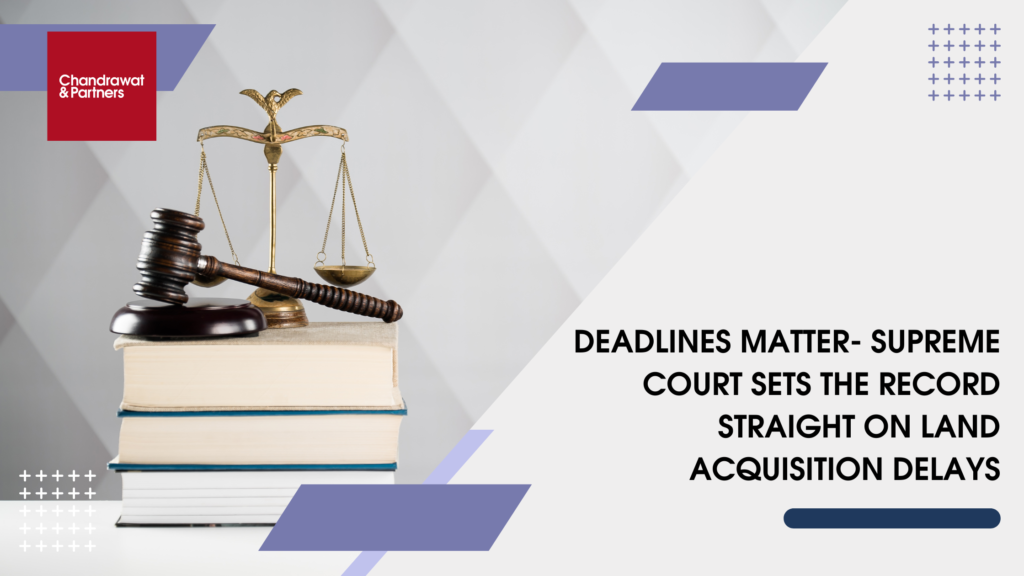
Share :
DEADLINES MATTER- SUPREME COURT SETS THE RECORD STRAIGHT ON LAND ACQUISITION DELAYS
The latest ruling by the Supreme Court in Delhi Development Authority v. Tejpal & Ors. (SLP (C) No. 26697 of 2019) has brought clarity to the contentious issue of excessive delays that affect land purchase procedures in India. This case arose from land acquisition initiated by the Delhi development Authority (“DDA”) way back in 1957 for a development project in Delhi. Despite over six decades having elapsed, the acquisition remained overdue in legal challenges. The prolonged delay in this matter raised important questions regarding the limits of justifiable delays, potential violations of landowner’s rights, and determination of higher compensation after passage of time.
BACKGROUND OF THE CASE
The matter revolved around the timeliness of the land acquisition process. The core question was whether the DDA’s purchase of the Respondents’ land in case of delays in the acquisition proceedings valid? The Land Acquisition Act, 1894, establishes specific timeframes for various stages of acquisition. Delays exceeding these timeframes could potentially invalidate the entire acquisition.
Another crucial aspect of the case was whether Respondents were entitled to compensation for the land that was acquired. Additionally, the court have considered if there were any outstanding compensation dues on the DDA’s part.
CHANGING LEGAL LANDSCAPE
The legal landscape surrounding land acquisition in India witnessed a seismic shift with the arrival of the Land Acquisition Act, 2013. This new Act brought about a wave of reforms, most notably Section 24. This provision dealt with the fate of land acquisition proceedings initiated under the previous Land Acquisition Act, 1894. Section 24 laid out specific conditions, such as non-payment of compensation or non-possession of land, under which these earlier proceedings would be deemed lapsed. However, the interpretation of Section 24 itself became a battleground. In a series of judgments, the Supreme Court grappled with its complexities. Cases like Pune Municipal Corporation v. Harak Chand Mistrimal Solanki, and Indore Development Authority v. Shailendra face the nuances of this provision. Ultimately, a five-judge bench in the landmark judgment of Indore Development Authority v. Manoharlal ,overruled the earlier cases, providing clarity on Section 24 of the Act and its impact on the surplus of land acquisition disputes that had been simmering for years. This decisive judgment established a clear legal precedent, paving the way for a more streamlined and predictable approach to resolving these long-standing land acquisition issues.
THE SUPREME COURT’S OBSERVATIONS
- The court emphasized the importance of finality in judgments. Overruling a previous judgment only affects its binding nature as a precedent, not the specific dispute already decided by that judgment.
- The court highlighted the importance of adhering to limitation periods, which are the deadlines for filing legal claims. This ruling serves as a reminder to parties involved in legal disputes to pursue their claims within the stipulated timeframe.
- The court acknowledged the need for some flexibility, especially in cases with exceptional circumstances or public interest concerns. However, the emphasis remains on maintaining stability and predictability in the legal system.
OVERRULING’S LIMITED IMPACT
The court clarified that when a judgment is overruled, its binding nature as a precedent is nullified, but the lis (dispute) between the parties is still deemed settled by the overruled case. The mere overruling of a case does not reopen the disputes between the parties, as the overruling only impacts the precedential value and not the final adjudication of the specific case.
Subsequent change of law will not be attracted unless a case is pending before the competent court awaiting its final adjudication. If a case has already been decided, it cannot be reopened and re-decided solely on the basis of a new interpretation given to that law.
IMPLICATIONS AND SIGNIFICANCE
Upholding the Sanctity of Limitation Periods: The court’s ruling underscores the paramount importance of adhering to prescribed limitation periods and the finality of adjudicated cases, even in the face of evolving legal interpretations. It serves as a cautionary reminder to litigants and legal professionals to diligently pursue their claims within the stipulated timeframes.
Balancing Finality and Evolving Jurisprudence: The court struck a delicate balance between upholding the sanctity of limitation laws and maintaining the stability and certainty of the judicial process, while still allowing for exceptions in exceptional circumstances, such as matters of public interest.
Guidance for Legal Practitioners: The ruling provides valuable guidance for legal practitioners and litigants in navigating the intricate terrain of limitation laws and evolving jurisprudence. It emphasizes the need for a comprehensive understanding of the evolving legal landscape and the judicious application of subsequent changes in law within the confines of established judicial doctrines.
CONCLUSION
The Supreme Court’s landmark ruling in the Delhi land acquisition cases reinforces the fundamental principles of adherence to procedural norms, respect for the finality of judgments, and the judicious application of subsequent changes in law within established doctrines. This decision serves as a significant precedent, ensuring stability and certainty in the legal system while allowing for necessary flexibility in exceptional circumstances.
For more information or queries, please email us at
[email protected]



